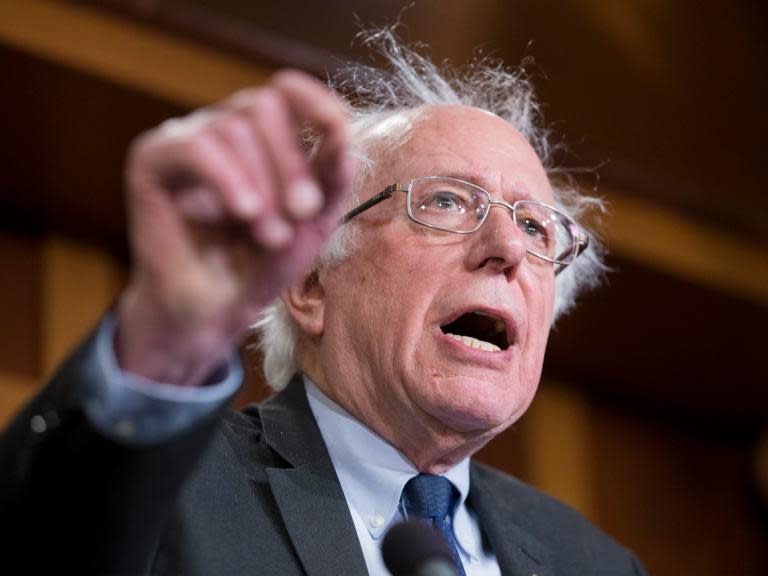If Bernie Sanders wants to do better with voters of colour, here's where he needs to start
The US presidential election is more than a year away, but the Democratic Party already has a long list of 2020 hopefuls, one of the most diverse in US history — aesthetically at least. It includes a record number of women — five, to be exact; Pete Buttigeig, an openly gay man; Julián Castro, who is Mexican-American; and two African-Americans, Cory Booker and Kamala Harris, who also has Indian heritage.
As late as 18 February, when there was no clear leader, Harris, a Senator for California — who has frustratingly been dubbed the “female Barack Obama” — looked like the strongest contender for the Democratic nomination. I say “frustratingly” because my sense was (and still is) that she was given this moniker because of her mixed heritage (as it turns out, she was apparently called that by the commentators involved because both of her parents are immigrants.)
Not only does Kamala Harris check many boxes, but she’s a relatively young, black and non-white woman (yes, that is a distinction), with politics that appeal to a broad base. She also received early endorsements from heavy hitters including the civil rights icon Dolores Huerta.
But then Bernie Sanders announced he was making a bid for the White House. Again.
According to the New York Times, 24 hours after his announcement, the Sanders campaign revealed it had raised $6m. The average donation was $27.
“Why did Sanders decide to run again?” was the question on everybody’s lips this week. After all, if the historic wins by women of colour in the 2018 midterm elections were anything to go by, we can assume Democratic voters may well choose a woman of colour over a white man in the nominations. The issue of his age was also mentioned a lot in the past few days: Sanders is 77, much older than most of his other compatriots standing.
Sanders told Vermont Public Radio that “we have got to look at candidates, you know, not by the color of their skin...not by their sexual orientation or their gender, and not by their age. I think we’ve got to… look at people based on their abilities ... based on what they stand for.”
True, no one should be judged by “what” they are. Unfortunately — as Senator Sanders knows, because he is running a campaign to end inequality — that isn’t the case in reality. That said, his policies, like Medicare-for-All and his push to address wealth inequality — all of which were seen as radical three short years ago — have now been embraced, sometimes reluctantly, by the Democratic Party. They’ve also been included in the political platforms of his competitors in one way or another.
In other words, Sanders is no longer the underdog.
But Sanders isn’t the only challenge for the Democratic hopefuls. They have their own challenges. Julián Castro has been accused of being too inexperienced; Cory Booker has to fight perceptions that he’s a Wall Street ally; and in addition to making sure she stays likeable to the public, because: sexism, Kamala Harris will also have to address her decades-old anti-truancy program, which disproportionately affected black and Latino families.
In 2016, just over 23 percent of African-Americans who voted in the 2016 primary wanted Sanders as the Democratic nominee, and it’s clear he’s going to have to do more to get people of colour on his side this time round. This, despite the fact that he has supported candidates of colour who canvassed on issues like voting rights and immigration. In 2018, Sanders supported two African-American gubernatorial candidates: Andrew Gillum in Florida and Stacey Abrams in Georgia. They both lost their tight races. When asked why he thought they lost, Sanders told the Daily Beast, “[A lot] of white folks out there who are not necessarily racist ... felt uncomfortable for the first time in their lives about whether or not they wanted to vote for an African-American”.
The thing is, what Sanders described was at best racial bias. But he didn’t — or couldn’t — bring himself to say it.
These days, Sanders has become more strident when calling racism out, at least when it comes to President Trump, who he called “racist” and “xenophobic” during his interview with Vermont Public Radio. He says that he’s learned a lot about all Americans, and as a result he intends to run a campaign that will help all working people, “whether they’re black or white, Latino, Native American, Asian-American…”
It’s a tall order and only time will tell if the Senator from Vermont finds a way to connect with communities of colour more effectively than he did in 2016. I'm not entirely convinced he'll manage it, but he'd better act fast, because people of colour don't need to wait for him to figure it out.
Christabel Nsiah-Buadi is a writer and radio presenter who features on CBC, NPR, MTV and American Public Media

 Yahoo News
Yahoo News 

